Power management chips maker Monolithic Power Systems (NASDAQ:MPWR) beat analysts' expectations in Q1 CY2024, with revenue up 1.5% year on year to $457.9 million. Guidance for next quarter's revenue was also optimistic at $490 million at the midpoint, 3.6% above analysts' estimates. It made a non-GAAP profit of $2.81 per share, down from its profit of $3.00 per share in the same quarter last year.
Monolithic Power Systems (MPWR) Q1 CY2024 Highlights:
- Revenue: $457.9 million vs analyst estimates of $445 million (2.9% beat)
- EPS (non-GAAP): $2.81 vs analyst estimates of $2.64 (6.4% beat)
- Revenue Guidance for Q2 CY2024 is $490 million at the midpoint, above analyst estimates of $472.9 million
- Gross Margin (GAAP): 55.1%, down from 57.4% in the same quarter last year
- Inventory Days Outstanding: 175, up from 172 in the previous quarter
- Market Capitalization: $32.57 billion
Founded in 1997 by its longtime CEO Michael Hsing, Monolithic Power Systems (NASDAQ:MPWR) is an analog and mixed signal chipmaker that specializes in power management chips meant to minimize total energy consumption.
Monolithic Power Systems’ peers and competitors include Analog Devices (NASDAQ:ADI), Texas Instruments (NASDAQ:TXN), Skyworks (NASDAQ:SWKS), Infineon (XTRA:IFX), NXP Semiconductors NV (NASDAQ:NXPI), ON Semi (NASDAQ:ON), Marvell Technology (NASDAQ:MRVL), and Microchip (NASDAQ:MCHP).Analog Semiconductors
Longer manufacturing duration allows analog chip makers to generate greater efficiencies, leading to structurally higher gross margins than their fabless digital peers. The downside of vertical integration is that cyclicality can be more pronounced for analog chipmakers, as capacity utilization upsides work in reverse during down periods.
Sales Growth
Monolithic Power Systems's revenue growth over the last three years has been strong, averaging 27.8% annually. But as you can see below, this quarter wasn't particularly strong, with revenue growing from $451.1 million in the same quarter last year to $457.9 million. Semiconductors are a cyclical industry, and long-term investors should be prepared for periods of high growth followed by periods of revenue contractions (which can sometimes offer opportune times to buy).
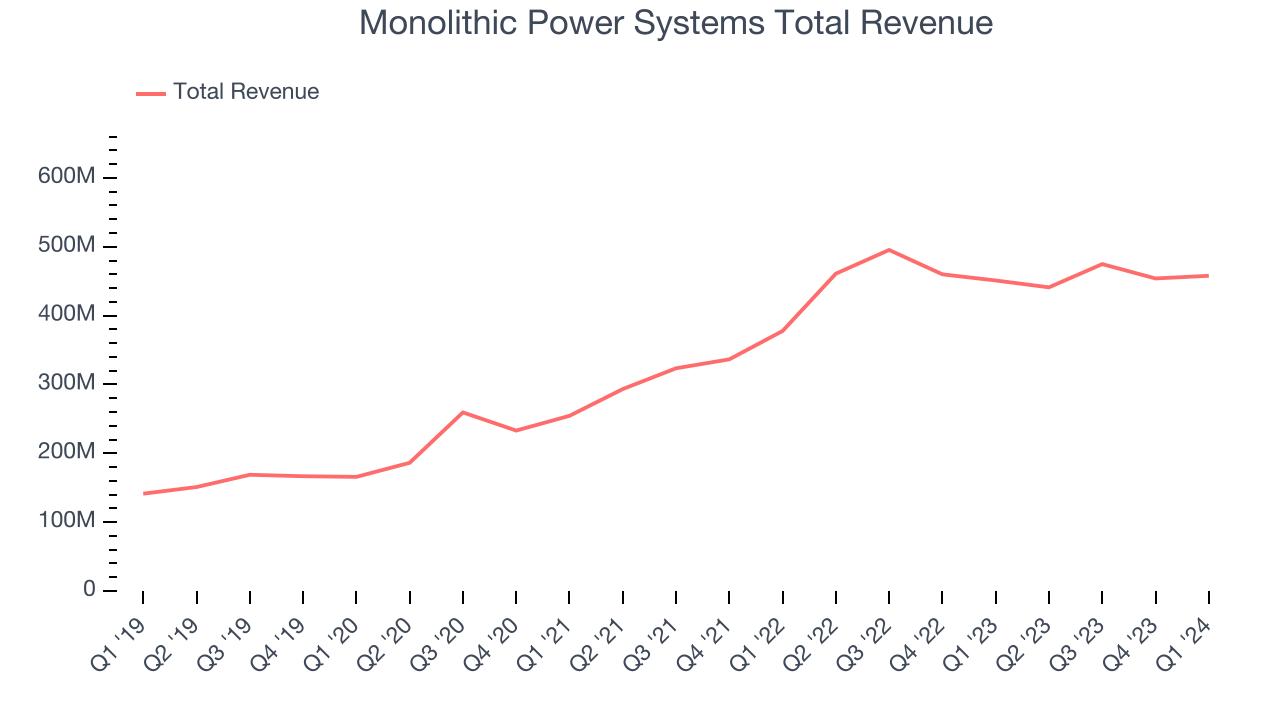
While Monolithic Power Systems beat analysts' revenue estimates, this was a sluggish quarter for the company as its revenue only grew 1.5% year on year. Monolithic Power Systems's growth, however, flipped from negative to positive this quarter. This encouraging sign will likely be welcomed by shareholders.
Monolithic Power Systems returned to positive revenue growth this quarter and its management team expects the trend to continue. The company is guiding to 11.1% year-on-year growth next quarter, and analysts seem to agree, forecasting 16.5% growth over the next 12 months.
Product Demand & Outstanding Inventory
Days Inventory Outstanding (DIO) is an important metric for chipmakers, as it reflects a business' capital intensity and the cyclical nature of semiconductor supply and demand. In a tight supply environment, inventories tend to be stable, allowing chipmakers to exert pricing power. Steadily increasing DIO can be a warning sign that demand is weak, and if inventories continue to rise, the company may have to downsize production.
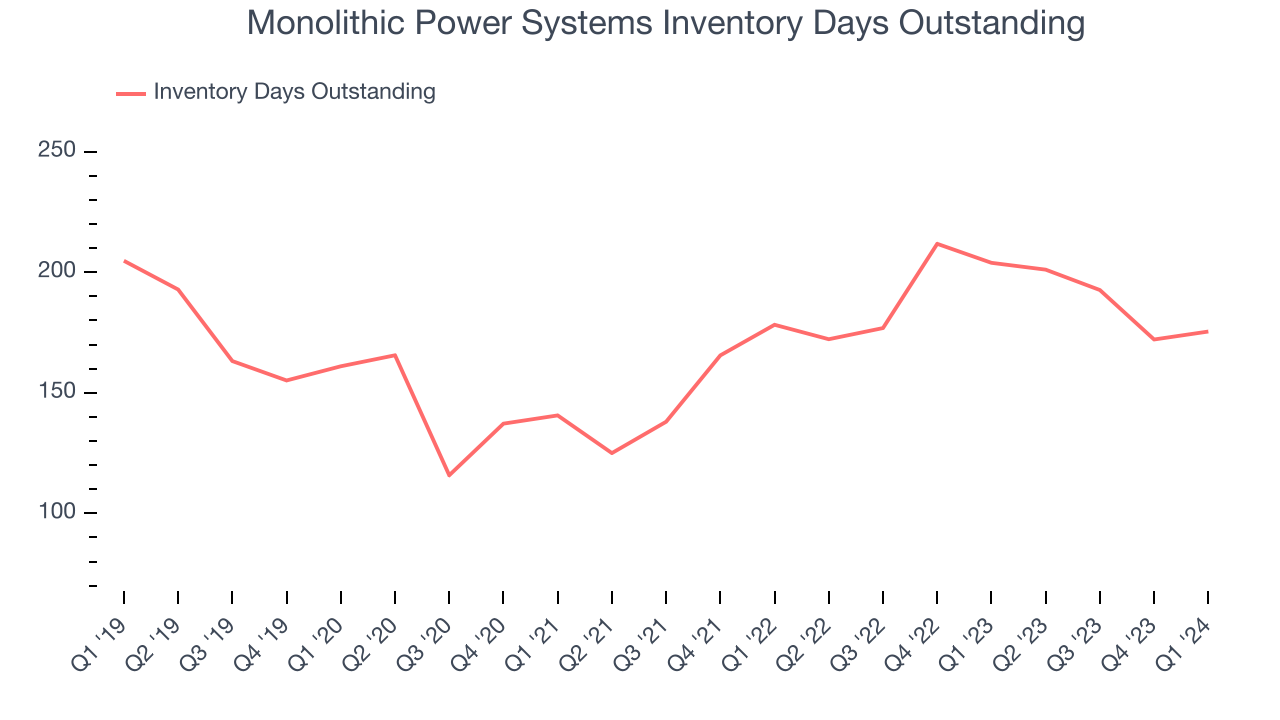
This quarter, Monolithic Power Systems's DIO came in at 175, which is 8 days above its five-year average, suggesting that the company's inventory has grown to higher levels than we've seen in the past.
Pricing Power
In the semiconductor industry, a company's gross profit margin is a critical metric to track because it sheds light on its pricing power, complexity of products, and ability to procure raw materials, equipment, and labor. Monolithic Power Systems's gross profit margin, which shows how much money the company gets to keep after paying key materials, input, and manufacturing costs, came in at 55.1% in Q1, down 2.2 percentage points year on year.
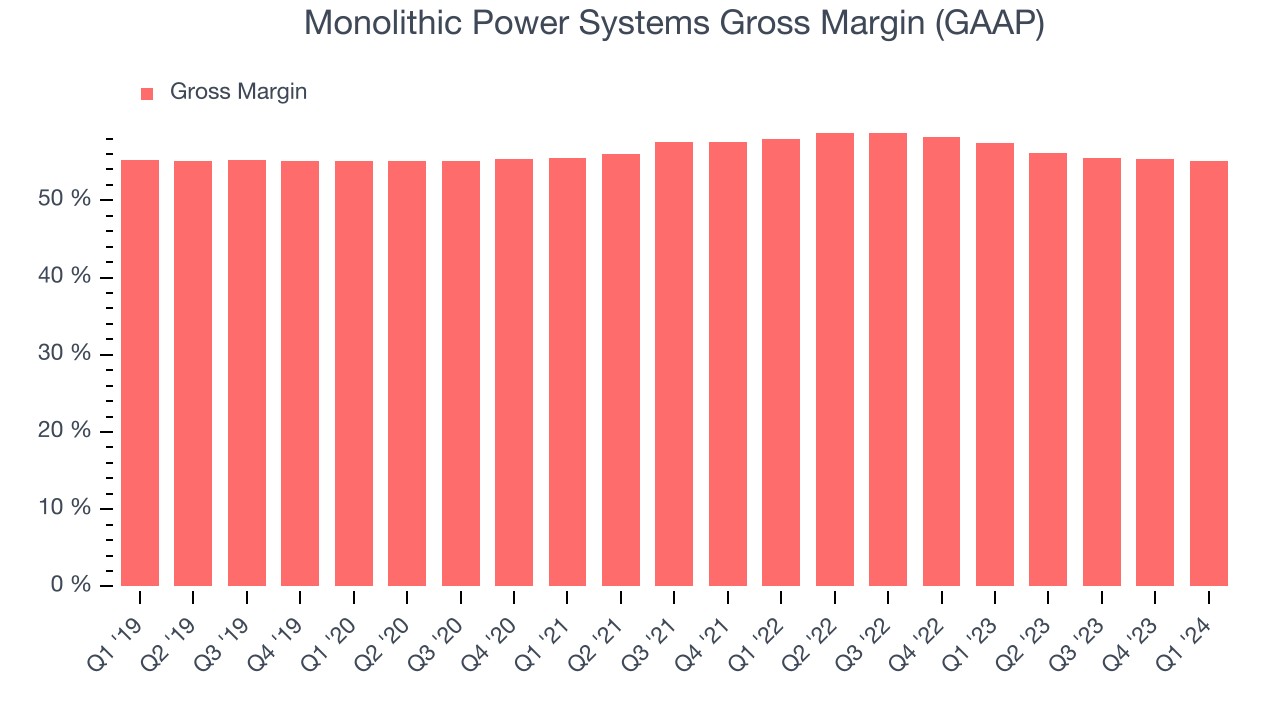
Despite declining over the last 12 months, Monolithic Power Systems still retains reasonably high gross margins, averaging 55.5%. These margins point to its solid competitive offering, disciplined cost controls, and lack of significant pricing pressure.
Profitability
Monolithic Power Systems reported an operating margin of 33.1% in Q1, down 3.3 percentage points year on year. Operating margins are one of the best measures of profitability because they tell us how much money a company takes home after manufacturing its products, marketing and selling them, and, importantly, keeping them relevant through research and development.
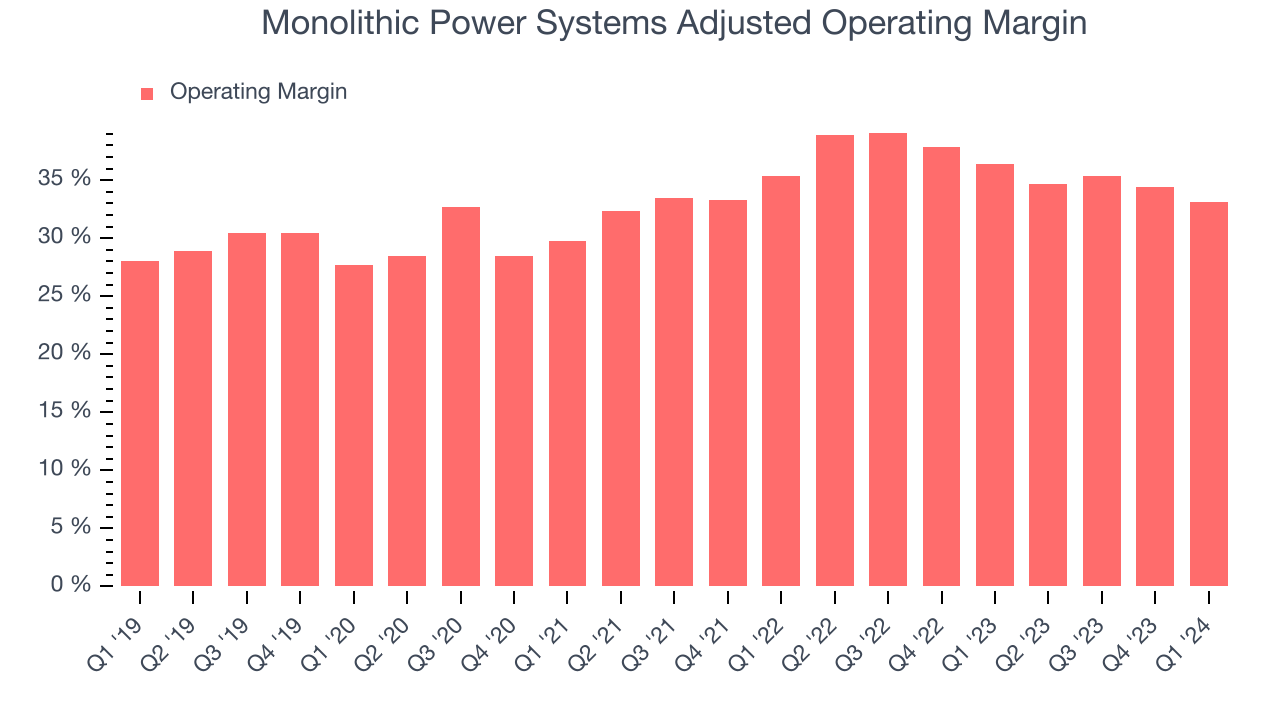
Monolithic Power Systems's operating margins have been trending down over the last year, averaging 34.4%. However, the company's profitability is still above average for semiconductor companies, driven by an efficient cost structure.
Return on Invested Capital (ROIC)
EPS and free cash flow tell us whether a company was profitable while growing revenue. But was it capital-efficient? A company’s ROIC explains this by showing how much operating profit a company makes compared to how much money the business raised (debt and equity).
Monolithic Power Systems's five-year average ROIC was 47.2%, placing it among the best semiconductor companies. Just as you’d like your investment dollars to generate returns, Monolithic Power Systems's invested capital has produced excellent profits.
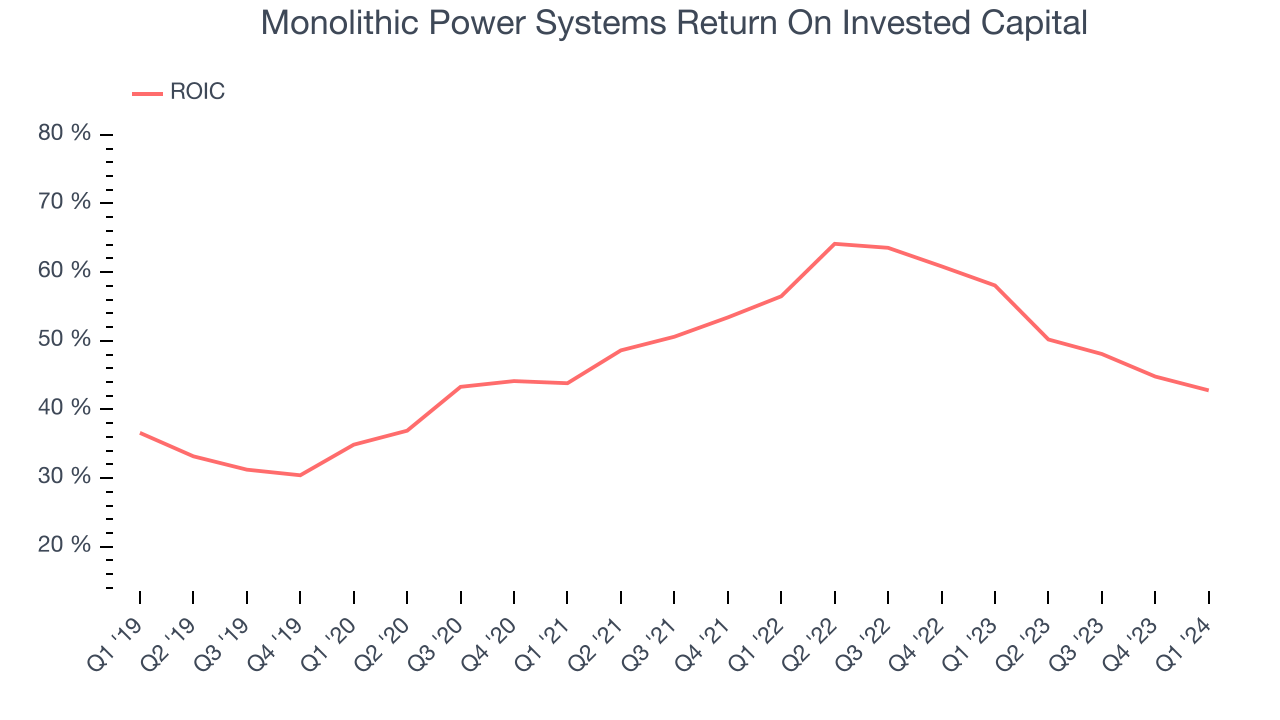
The trend in its ROIC, however, is often what surprises the market and drives the stock price. Over the last few years, Monolithic Power Systems's ROIC averaged 11.1 percentage point increases. The company has historically shown the ability to generate good returns, and its rising ROIC is a great sign. It could suggest its competitive advantage or profitable business opportunities are expanding.
Key Takeaways from Monolithic Power Systems's Q1 Results
We were impressed by how significantly Monolithic Power Systems blew past analysts' EPS expectations this quarter. We were also glad next quarter's revenue guidance came in higher than Wall Street's estimates. On the other hand, its gross margin declined and its operating margin decreased. Overall, this quarter's results still seemed fairly positive and shareholders should feel optimistic. The stock is up 2.2% after reporting and currently trades at $665 per share.
Is Now The Time?
When considering an investment in Monolithic Power Systems, investors should take into account its valuation and business qualities as well as what's happened in the latest quarter.
There are numerous reasons why we think Monolithic Power Systems is one of the best semiconductor companies out there. While we'd expect growth rates to moderate from here, its impressive revenue growth over the last three years suggests it's increasing its market share. Additionally, its powerful free cash generation enables it to sustainably invest in growth initiatives while maintaining an ample cash cushion, and its stellar ROIC suggests it has been a well-run company historically.
The market is certainly expecting long-term growth from Monolithic Power Systems given that its price-to-earnings ratio based on the next 12 months of 47.9x is much higher than other semiconductor companies. But looking at the semiconductors landscape today, Monolithic Power Systems's qualities as one of the best businesses really stand out and we still like it at this price, despite the higher multiple.
Wall Street analysts covering the company had a one-year price target of $758.08 per share right before these results (compared to the current share price of $665), implying they saw upside in buying Monolithic Power Systems in the short term.
To get the best start with StockStory check out our most recent Stock picks, and then sign up to our earnings alerts by adding companies to your watchlist here. We typically have the quarterly earnings results analyzed within seconds of the data being released, and especially for the companies reporting pre-market, this often gives investors the chance to react to the results before the market has fully absorbed the information.
